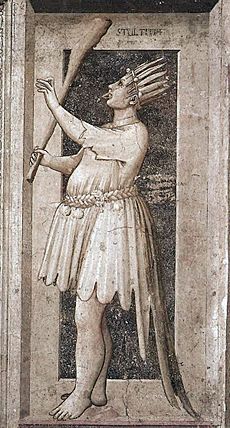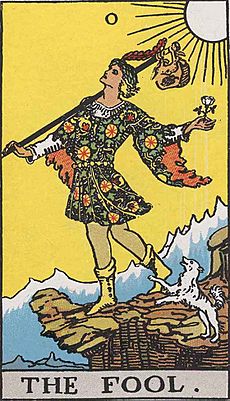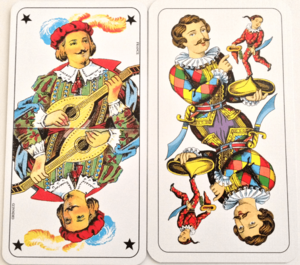The Fool (tarot card) facts for kids
The Fool is a special card found in a tarot deck, which usually has 78 cards. When people use tarot cards for reading fortunes or understanding themselves, the Fool is one of the 22 most important cards, called the Major Arcana. It can be numbered as 0 (the first card) or XXII (the last card).
However, in older tarot decks made for playing games, the Fool usually doesn't have a number. This is because it's not one of the 21 trump cards. Instead, it has its own special role in the game.
Contents
What the Fool Looks Like

In some old tarot decks, like the Tarot of Marseilles, the Fool is called Le Mat (in French) or Il Matto (in Italian). These old words mean "the madman" or "the beggar." They might even be connected to the word "checkmate" from chess, since tarot cards were first used for games.
In the very first tarot decks, the Fool often looked like a beggar or someone wandering around. For example, in the Visconti-Sforza tarot deck, the Fool wears torn clothes and carries a stick with a bundle on his back. He might even have feathers in his hair. This look could be linked to old stories about wild people living in the woods.
Other old decks, like the Tarot of Marseilles, show a bearded person wearing a hat that looks like a jester's hat. This Fool also carries a bundle on a stick. Often, an animal, like a dog or a cat, is shown chasing him, and it might even be tearing his pants!
In newer decks, like the Rider–Waite Tarot deck, the Fool looks like a young man walking happily towards the edge of a cliff, not knowing the danger. He has a small dog with him. He holds a white rose, which means he is free from bad desires. In his other hand, he carries a small bundle, which stands for all the knowledge he hasn't used yet.
In French tarot decks, which use different pictures for the trump cards, the Fool often looks like a jester or a bard. This is similar to the Joker card you might find in a regular deck of 52 playing cards.
History of the Fool Card
Before the Rider–Waite deck became popular, the Fool card usually didn't have a number. But there were some exceptions! Some very old decks from the 1400s, like the Sola Busca tarot, gave the Fool the number 0. Also, some Belgian decks from the 1700s numbered the Fool as XXII.
Historically, the Fool was often seen as separate from the other trump cards. However, some traditions considered it the lowest trump, while others saw it as the highest.
Most of the important tarot cards, the Major Arcana, are numbered with Roman numerals (like I, II, III). But the Fool is often numbered with a zero, which is an Arabic numeral.
Many people believe that the Fool card might be the ancestor of the Joker card we use in modern playing card decks today.
The Fool in Tarot Card Games
In tarot card readings, the Fool is part of the Major Arcana. But in tarot card games, its role is different. The Fool doesn't belong to any suit and isn't a regular trump card. Because of this, most old game decks don't give the Fool a number to show its rank.
The Rider–Waite deck gives the Fool the number 0. The only traditional game deck that numbers the Fool as 0 is the Tarocco Piemontese. In many tarot games, the Fool is one of the most valuable cards.
The Fool as an "Excuse"
In most tarot games from Italy and France, the Fool has a special job. It's often called "the Excuse." Tarot games are usually trick taking games, where players try to win "tricks" (a round of cards). When you play the Fool card, it lets you avoid playing a card of the correct suit or a trump card.
After the trick is over, you take the Fool back and add it to your own pile of won cards. Then, you usually give the player who won the trick your least valuable card from your pile. If you don't have a card to give, the Fool is worth one point less, and the trick winner gets an extra point. Sometimes, if a player or team wins all the tricks, they get the Fool. Usually, the Fool cannot be captured by other cards, but in some games, it can be won in the very last trick.
The Fool as the Lowest Trump
In an 18th-century game from Piedmont called Sedici, the Fool was treated as the lowest trump card. Unlike in most games, it was only worth one point. This is similar to how the Miseria trump works in Tarocco Siciliano.
The Fool as the Highest Trump
In many Central European Tarock games, the Fool, or Sküs, is simply played as the 22nd trump card. This makes it the highest trump in these games. For example, in Königrufen, the Fool can be captured, but only if it's played in the same trick with trumps 21 and 1. In that rare case, trump 1 wins!
The Fool as Both Excuse and Highest Trump
In French tarot and Droggn, the Fool is usually an "excuse." But in a very rare situation, it can become the highest trump. If the player holding the Fool has won all the tricks before the very last one, then in that final trick, the Fool becomes the most powerful trump.
In Troggu, the Fool is the highest trump. But if it's the last trump a player has, they can choose to play another card instead of following suit. Once this happens, the Fool is no longer a trump. It becomes an "excuse" that must be saved for the last trick.
The Fool in Media
- In the anime JoJo's Bizarre Adventure, a dog named Iggy has a special power called a Stand, named after The Fool. This Stand can control sand.
- In the Persona video game series, the main characters in the third, fourth, and fifth games are linked to The Fool arcana.
- In the Street Fighter video game series, The Fool card is used to represent characters like Ryu (Street Fighter) and G.
- In the Adventure Time miniseries Stakes, one of the Vampire King's helpers is named after The Fool.
Images for kids
-
The Fool from the Pierpont Morgan Bergamo (around 1451)
See also
 In Spanish: El Loco (Tarot) para niños
In Spanish: El Loco (Tarot) para niños
- Divine madness
- Sacred fool












